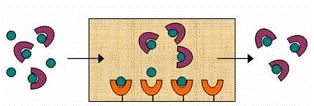Department of Chemistry
Document Type
Article
Date of this Version
12-2008
Citation
Published in final edited form as: Clin Chim Acta. 2008 December ; 398(1-2): 63–69. doi:10.1016/j.cca.2008.08.013. Version presented here is from NIH PubMed Central.
Abstract
Background—A system was developed for the simultaneous measurement in urine of free catecholamines (i.e., dopamine, norepinephrine, epinephrine) and creatinine (i.e., an indicator of urine output and volume). This method was based on the use of tandem affinity/ion-pair HPLC and flow injection analysis.
Methods—The free catecholamines were extracted directly from urine by using an on-line phenylboronic acid affinity column. The extracted solutes were then separated and measured by ionpair chromatography followed by amperometric detection. Creatinine was measured by an on-line flow injection analysis system based on the Jaffe reaction, which analyzed creatinine as it eluted nonretained from the phenylboronic acid column.
Results—Various factors were considered in the design and optimization of the phenylboronic acid column, the tandem affinity/ion-pair HPLC columns and the flow injection analysis system. The total analysis time for the final combined system was approximately 16 min per injection at 1 ml/min. This method was found to have good agreement with the expected results for control urine samples. The limits of detection for 20 μl samples (S/N = 3.0) were 1.8, 1.0 and 4.3 μg/l for norepinephrine, epinephrine and dopamine, respectively, while the limit of detection of creatinine was 5.0 mg/l. The linear response of this method extended over a 450 to 930-fold range in concentration for the catecholamines and covered the range of clinical interest. The within-day precision of this method was ±2.0−2.7%.
Conclusions—The ability of this method to simultaneously monitor both creatinine and other analytes makes this HPLC/FIA system an attractive method for use in monitoring urinary compounds. With this approach it was possible to provide fast results for small volumes of random urine samples that were collected as part of a psychological study. The same method could also be utilized with 12 or 24 h urine specimens.



Comments
Copyright Elsevier Inc. Used By Permission.